Liberation of Crimea: breakthrough of the defense of the German 17th Army
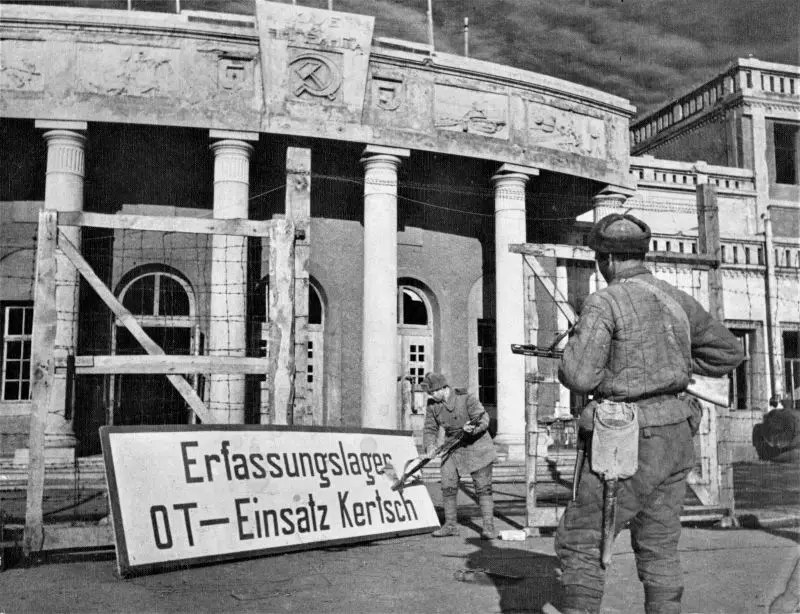
Soldiers of the 2nd Guards Taman Division tear down a fascist sign from the club named after. Engels in Kerch. At the club named after Engels during the occupation, a Soviet prisoner of war camp was located
Assault
80 years ago, the forces of the 4th Ukrainian Front and the Separate Primorsky Army in cooperation with the Black Sea fleet and the Azov military flotilla began an operation to liberate Crimea (How 80 years ago the Red Army began the liberation of Crimea).
The 17th Wehrmacht Army defended on the peninsula under the command of General Erwin Jenecke, consisting of 5 German and 7 Romanian divisions. In total, over 195 thousand people, about 3 guns and mortars, 600 tanks and assault guns, 148 aircraft. The headquarters of the 17th Army was located in Simferopol.
In the northern part of Crimea the following defended: the German 49th Mountain Army Corps (50th, 111th and 336th Infantry Divisions, 279th Assault Gun Brigade); 3rd Romanian Cavalry Corps (9th Cavalry, 10th and 19th Infantry Divisions). The headquarters of the 49th Mountain Infantry and 3rd Romanian Cavalry Corps were located in Dzhankoy. In the same area there were also reserves in this direction - the 111th Infantry Division (minus one regiment), the 279th Assault Gun Brigade (Voinka), one regiment of the 9th Romanian Cavalry Division.
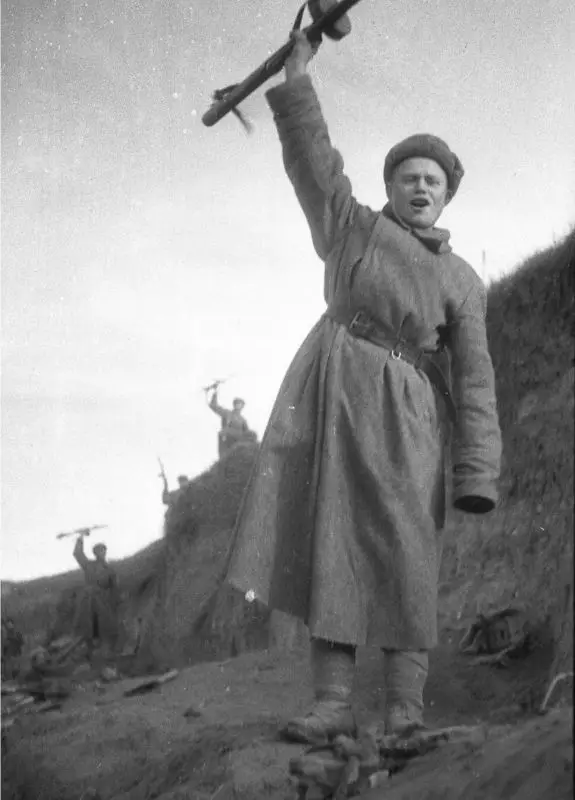
Red Army soldiers after the assault and breakthrough of the German fortifications of the Turkish Wall. Area of the village of Perekop near the city of Armyansk
On the evening of April 7, 1944, Soviet troops conducted reconnaissance in force, which confirmed previous information about the location of enemy positions in the area of Perekop and Sivash. Before the offensive, heavy artillery struck long-term enemy installations for several days. To quickly break through enemy defenses, high densities of artillery were created in breakthrough areas - up to 150 guns and mortars per 1 km of front.
On April 8, at 8 o’clock in the morning, powerful artillery preparation began in the zone of the 4th Ukrainian Front, which lasted 2,5 hours. She was accompanied aviation attacks on German positions. Immediately after the artillery barrage, the troops of the 4th UV went on the offensive.
The commander of the 17th German Army, having correctly determined the main direction of attack of the Soviet 51st Army, quickly brought up army reserves. The fighting became fierce. The 1st Guards and 10th Rifle Corps (commanded by Generals I.I. Missan and K.P. Neverov) of the 51st Army in the Tarkhan-Ishun direction, which delivered the main blow, were able to break through only the first and partially the second enemy trenches.
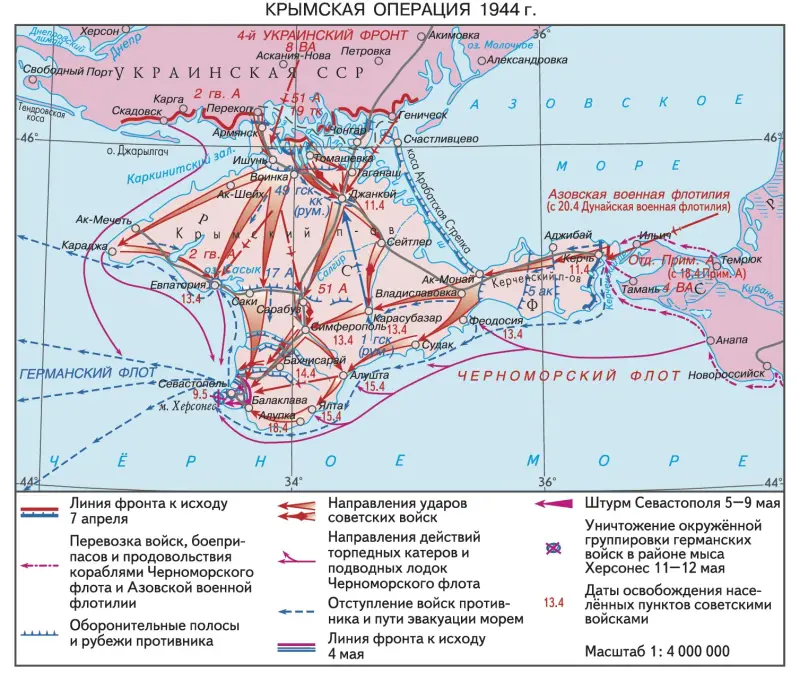
Advancing in the auxiliary directions - Karankino and Toytyubinsky, the 63rd Rifle Corps of General P.K. Koshevoy acted more successfully. He broke through the defenses of the 10th Romanian Infantry Division. On April 9, the front command, to develop the success of the corps, introduced a division of the second echelon of the same corps into the breakthrough, reinforcing it with a guards tank brigade and a guards tank regiment. The strike was also supported by artillery and aircraft of the 8th Air Force.
As a result, the auxiliary strike of the 51st Army began to develop into the main one. On April 9 there were fierce battles. The 63rd Corps, repelling fierce counterattacks by the 111th German Infantry Division, the 279th Assault Gun Brigade and the 10th Romanian Division, advanced 4–7 km, capturing several enemy strong points. The front command reinforced the rifle corps with a brigade of rocket artillery and transferred the 77th rifle division from the army reserve.
At the same time, Zakharov’s 2nd Guards Army was fighting heavily in the Perekop direction. On the first day of the offensive, the guards liberated Armyansk. By the end of the day on April 9, the army had failed the German defenses at Perekop. German troops began to retreat to the Ishun positions. At the same time, the Nazis constantly counterattacked. So, on April 9, soldiers of the 13th Guards and 54th Rifle Corps repelled 8 enemy counterattacks.
On the night of April 10, to facilitate the advance of the 13th Guards Corps, troops were sent to the rear of the Germans (a reinforced battalion under the command of Captain F.D. Dibrov and Captain M.Ya. Ryabov). For successful actions, the entire battalion was awarded state awards, and Dibrov was awarded the title of Hero of the Soviet Union.
By the end of April 10, the 51st and 2nd Guards Armies penetrated the German defenses at Sivash and Perekop.
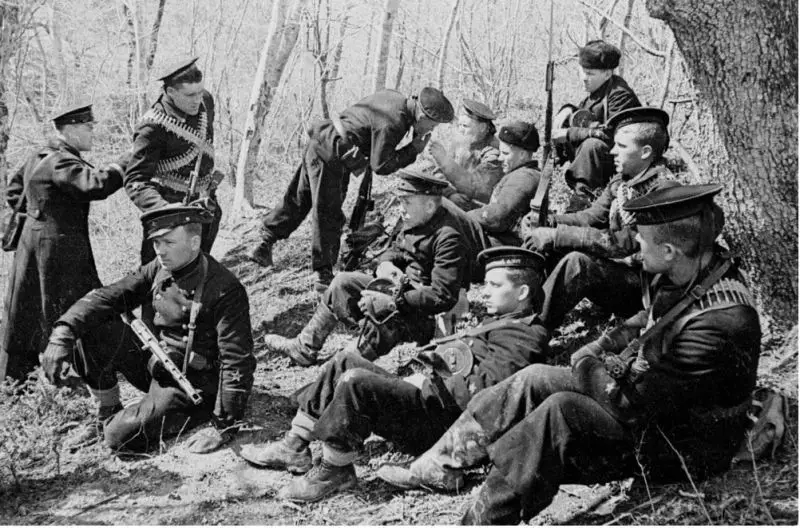
Marines at rest
Scorched Land Tactics
The command of the German 17th Army requested permission from the headquarters of Army Group A for the withdrawal of forces to Sevastopol. Permission was given. The 5th Army Corps, which held the defense on the Kerch Peninsula, received an order to retreat to Sevastopol. On April 10, the German command began evacuating rear services, transport, civil servants, collaborators and prisoners.
Hitler suspended the evacuation. On April 12, he ordered the defense of Sevastopol to the end and not to evacuate combat-ready units. This decision was opposed by the command of the 17th Army, Army Group “Southern Ukraine” and Chief of the General Staff of the Ground Forces Kurt Zeitzler. They wanted to preserve the combat effectiveness of the army. But the Fuhrer insisted on his decision.
The command of the 17th Army, realizing that Crimea could not be held, tried to carry out preparatory measures for the removal of troops. Already on April 8, the creation of evacuation groups began. First of all, they planned to remove units and subunits that did not directly participate in the hostilities. Only a small number of people were left for supplies and technical support. “Hiwis” – “voluntary assistants” of the Wehrmacht who served in auxiliary units, as well as former punitive forces, builders, counterintelligence and propaganda agencies were brought to the rear. They ordered to transport as much ammunition and food as possible to Sevastopol.
At the same time, the Germans began to destroy the infrastructure of Crimea. The German command planned to destroy or disable communications, harbors, ports, important economic buildings, airports, communications facilities, etc. According to the Nazi plan, the USSR had to spend a long time restoring Crimea and would not be able to use the peninsula as an operational base. Own military property was removed or rendered unusable.
The Germans did everything carefully and punctually. Roads were destroyed, villages burned, pillars were destroyed, people were killed. However, the advance of Soviet troops, assisted by partisans, was so rapid that most of the plan to destroy Crimea was never realized.
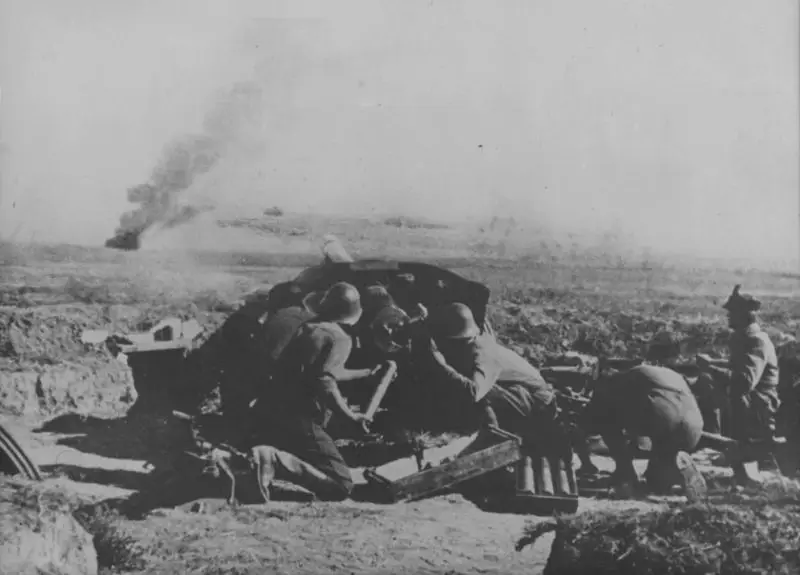
Romanian artillerymen fire from a 75mm PaK 97/38 L/36 anti-tank gun during a battle in Crimea.
Anti-tank 75-mm gun PaK 97/38 L/36 - modernized captured French or Polish 75-mm light field gun Schneider model 1897 by replacing the carriage with the carriage of the German anti-tank gun PaK 38.
Impact of the 19th Tank Corps
On April 10, 1944, Tolbukhin ordered the 19th Tank Corps to be pulled closer to the front line in order to throw it into battle on the morning of April 11. The tankers had to liberate Dzhankoy, and then advance in the direction of Simferopol - Sevastopol in order to cut through the enemy’s Crimean group and prevent the enemy from carrying out an organized retreat.
The 19th Tank Corps, with reinforcement units before the offensive, included: 187 tanks, 46 self-propelled guns, 14 armored personnel carriers, 31 armored vehicles, more than 200 guns and mortars, 15 BM-13 rocket launchers. Komkor Vasiliev, while inspecting the area, was seriously wounded by a fragment of a bomb dropped from an airplane, so his deputy, Colonel Potseluev, took command of the corps (although he was also slightly wounded). He commanded the corps until the end of the Crimean operation.
Before the 19th Tank Corps entered the battle, the Germans were unaware of its location on the Sivash bridgehead. The command of the 17th Army believed that the Soviet tank corps was in the Perekop area, where they expected the main attack of the 4th UV. Although all the equipment and weapons of the corps were transferred to a bridgehead south of Sivash in March 1944. To transport tanks, two crossings were created: a bridge on frame supports 1 m long and two earthen dams 865–600 m long with a pontoon bridge between them 700 m long.
For the purpose of camouflage, a false bridge was built a kilometer from the real crossings. The crossing was carried out at night or in bad weather conditions. Engineers and sappers prepared camouflaged shelters. The tracks of the caterpillars were covered. Therefore, the attack by Soviet tankers at Sivash was unexpected for the enemy.
At 5 o'clock on April 11, troops of the 63rd Rifle Corps, with the support of the 19th Tank Corps, completed the breakthrough of the German defense in the Sivash sector. Soviet tank crews were rapidly advancing towards Dzhankoy. Already at 11 o'clock on April 11, the advance detachment broke into the northern part of the city. Motorized riflemen supported the attack from the south.
The German garrison, consisting of up to an infantry regiment, two artillery divisions, four assault guns and an armored train, stubbornly defended itself. The city was liberated from the Nazis by the evening of April 11. In addition, Soviet tank crews destroyed a German airfield in the Vesely area (15 km southwest of Dzhankoy) and captured an important railway bridge 8 km southwest of Dzhankoy.
On April 11, the command of 4 UV for the purpose of the quickest release of the Crimean peninsula formed a mobile front group. It included the 19 tank corps, the 279 rifle division (two regiments were mounted on vehicles) and the 21 th separate anti-tank artillery brigade. The mobile group was headed by the Deputy Commander of the 51 Army, Major General V. N. Razuvaev.
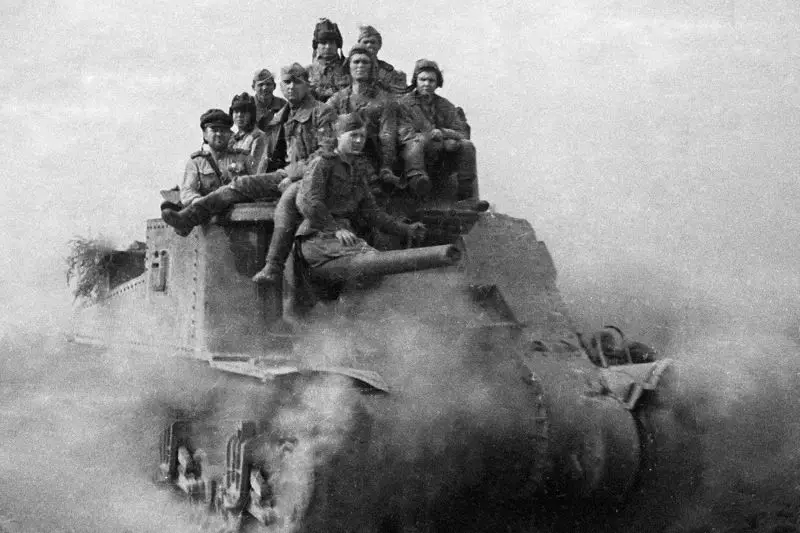
Soviet soldiers on the M3 General Lee tank (American-made, supplied to the USSR under Lend-Lease) are advancing in the Crimea
Kerch direction
The separate Primorsky Army under the command of Army General A.I. Eremenko (from April 15, Lieutenant General K.S. Melnik) planned to break through the enemy’s defenses north of Kerch, destroy the Kerch enemy group piece by piece, and prevent the enemy from leaving for the Ak-Monai positions. In the future, attack Simferopol and Sevastopol, part of the forces along the southern coast of the peninsula in order to liberate the ports with the support of the fleet.
The Kerch Peninsula was defended by the German 5th Army Corps (73rd and 98th Infantry Divisions and 191st Assault Gun Brigade), 6th Cavalry and 3rd Mountain Rifle Romanian Divisions.
Fearing that they would fall into the cauldron, the Nazis began to retreat to the Ak-Monai positions on the night of April 11. The withdrawal was promptly discovered by our reconnaissance. The troops of the Separate Primorsky Army went on the offensive. At 21:30 on April 10, after strong artillery and air preparation, the advanced units of the army went on the attack, and at 2:11 am on April 3, the main forces went on the attack. Formations of the XNUMXrd Mountain Rifle Corps under the command of General A.A. Luchinsky broke through the German defenses, occupied the well-fortified German stronghold of Bulganak and began to advance to the Turkish Wall.
Troops of the 11th Guards Corps under General S.E. Rozhdestvensky and the 16th Rifle Corps under General K.I. Provalov also broke through the German defenses and liberated Kerch. Our troops entered the city for the third time during the war. Many Germans and Romanians did not have time to escape and were captured.
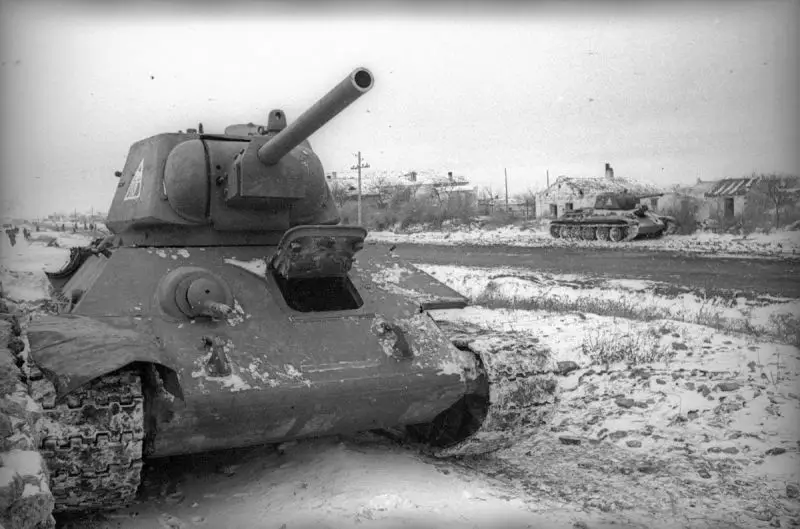
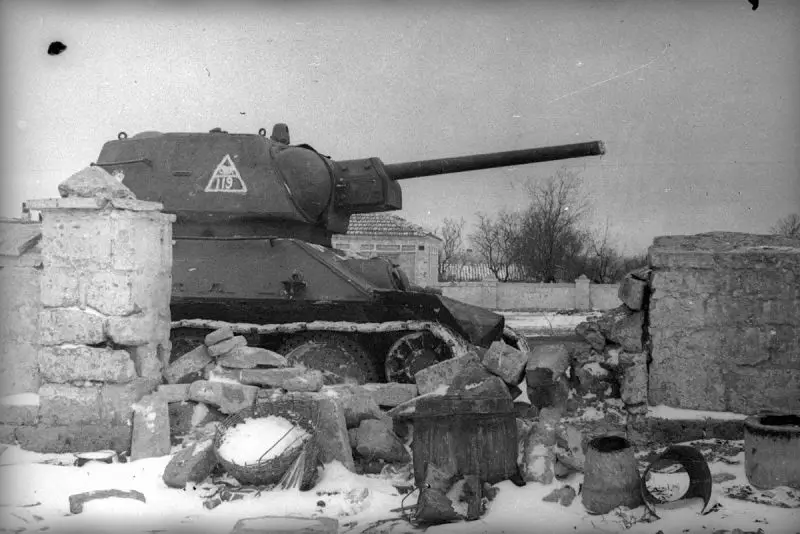
Tanks of the 1st tank battalion of the 63rd tank Taman brigade of the Separate Primorsky Army on the street of a village before the attack
On April 11, Supreme Commander Joseph Stalin expressed gratitude to the troops of the 4th Ukrainian Front, who broke through the powerful enemy defenses at Perekop, Sivash and liberated Dzhankoy, as well as the Separate Primorsky Army, which liberated Kerch. Fireworks went off in Moscow in honor of the victorious Soviet troops.
The long-suffering city was completely destroyed during the years of occupation. But even in the difficult conditions of Nazi terror, he did not stop fighting. Using quarries, the remnants of the defeated units of the Soviet troops and partisan detachments heroically fought the enemy on the Kerch Peninsula.
By decree of the Presidium of the Supreme Soviet of the USSR on September 14, 1973, for outstanding services to the Motherland, mass heroism and fortitude shown by the workers of Kerch and soldiers of the Soviet Armed Forces, and in commemoration of the 30th anniversary of the defeat of fascist troops during the liberation of Crimea, the city was awarded the honorary title “Hero City” "with the presentation of the Order of Lenin and the Gold Star medal.
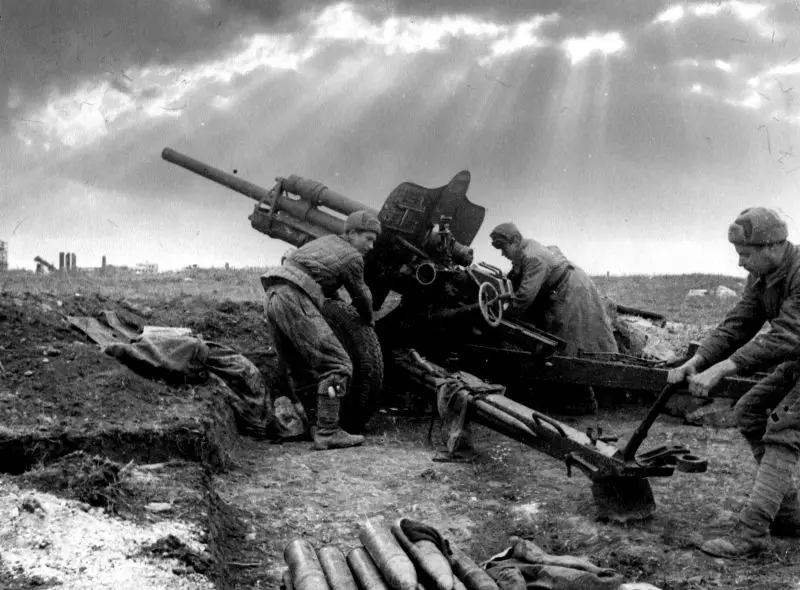
The crew of the Soviet 76-mm USV divisional gun under the command of Sergeant Borisov fires at the enemy in the battles for Kerch.
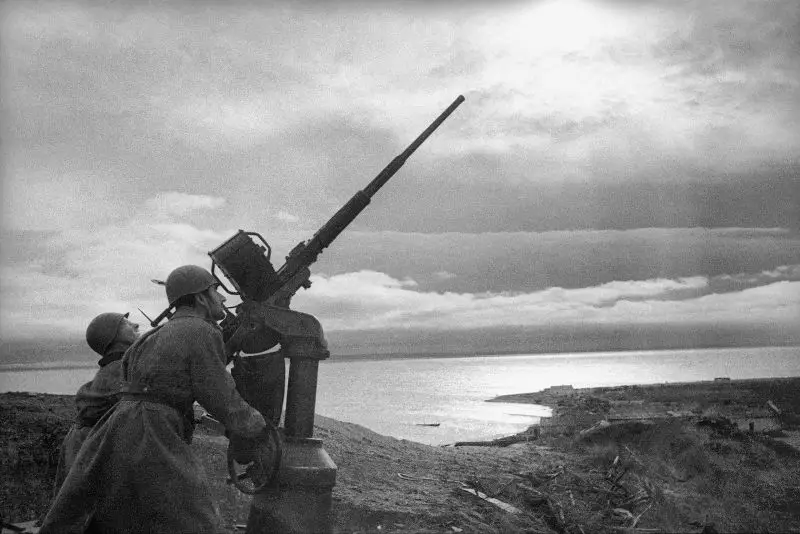
Crew of the Soviet 20-mm Oerlikon anti-aircraft gun on the coast in liberated Kerch.
On the morning of April 11, the troops of the Separate Primorsky Army began to pursue the retreating enemy along the southern coast of Crimea. The army mobile group went forward - the 227th Infantry Division of Colonel G. M. Preobrazhensky. The shooters were put on cars. The successful actions of the mobile group helped to break through the enemy’s second line of defense on the move, and the army advanced 40–46 km per day.
German and Romanian divisions retreat from the north and east of the peninsula towards Sevastopol. The Nazis destroy communications, roads, bridges, mine them, create rubble, in every possible way preventing the advance of the Red Army.
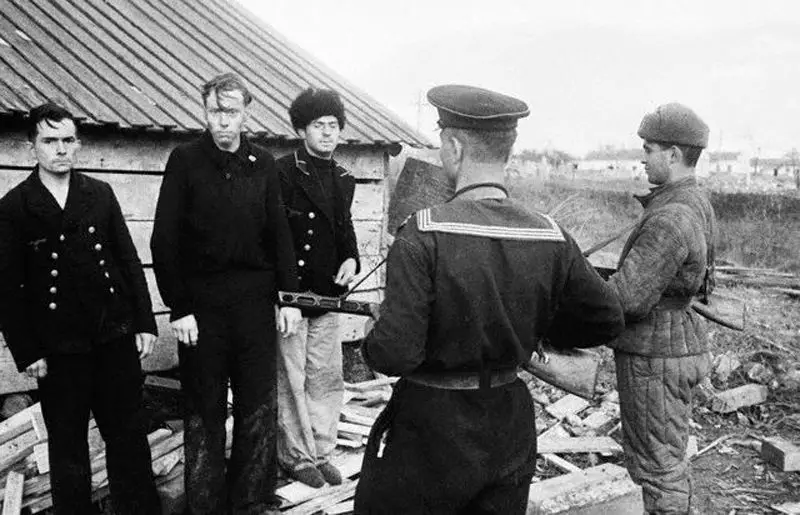
Captured German sailors near Kerch
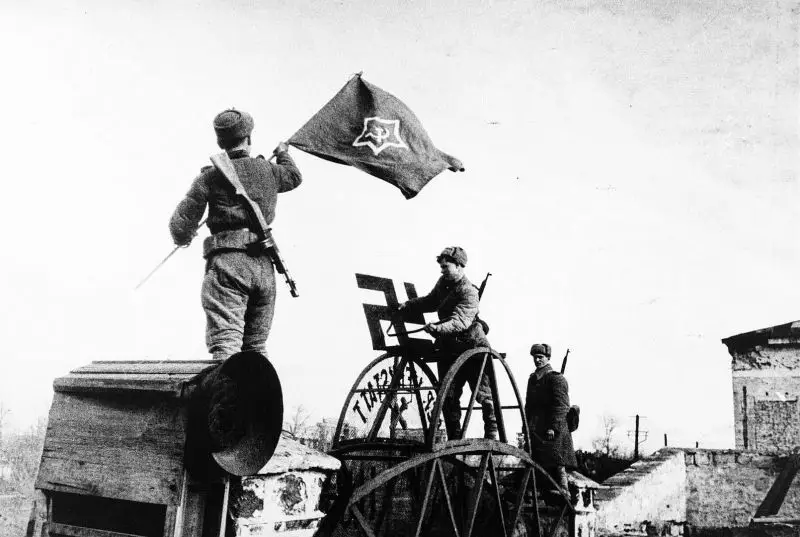
A Soviet soldier tears off a Nazi swastika from the gates of the metallurgical plant named after. Voykova in liberated Kerch. The second fighter prepares the Red Banner for installation. The city was finally liberated from the invaders on April 11, 1944. Plant named after Voykov was the scene of fierce fighting during the collapse of the Crimean Front and the surrender of Kerch in May 1942. The combined detachments of the 44th Army defended here, covering the crossing of the retreating Soviet troops through the Kerch Strait. The active phase of defense lasted from May 18 to August 5, 1942, after which the remnants of the defenders descended into the underground communications of the plant and from there continued the fight against the invaders. The last shootout at the plant named after. Voykov dates back to December 1942.
Information